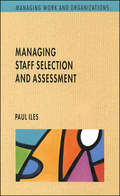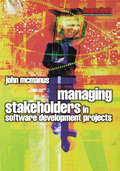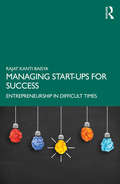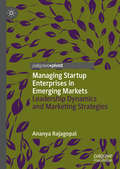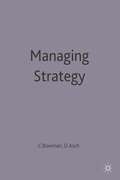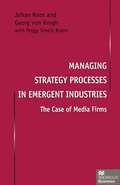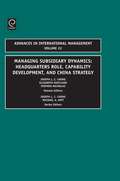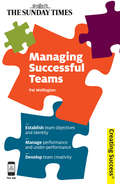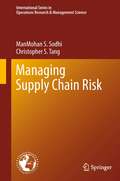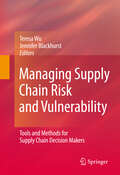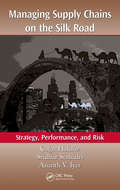- Table View
- List View
Managing Sports Teams: Economics, Strategy and Practice (Management for Professionals)
by Stefan Walzel Verena RömischThis handbook offers a comprehensive overview of the most important and fundamental elements for the management of team sports organisations. It is intended to meet the needs of full-time and voluntary individuals in management positions in professional and semi-professional sports clubs, leagues and federations, and those who aspire to such positions. In addition to management-relevant aspects, its interdisciplinary approach also includes the basics of law and media, which are vital to the successful management of team sports organisations. Bringing together experts from the respective disciplines, the book’s content is presented in a clear and straightforward manner, facilitating its implementation in practice.
Managing Staff Selection and Assessment (UK Higher Education OUP Humanities & Social Sciences Politics)
by Paul IlesPaul Iles provides a distinctive approach to managing staff selection and assessment in organizations. He discusses not only the dominant psychometric model but also draws upon perspectives from strategic management theory, social psychology, and critical theory. This is an accessible text which discusses developments both in the UK and internationally, provides specific organizational case studies, and describes recent research findings and their implications for organizational practice. It locates techniques and procedures in the contexts of corporate strategy, structure and culture. It shows how organizations have sought to use assessment strategically in the search for competitive advantage: recruiting, selecting, appraising and developing staff in order to bring about organizationaland cultural change. The book concludes by applying its frameworks to an area of key significance : the identification, assessment and development of managerial competence.
Managing Stakeholders in Software Development Projects (Computer Weekly Professional Ser.)
by John McManusAs stakeholder relationships and business in general have become increasingly central to the unfolding of stakeholder thinking, important new topics have begun to take centre stage in both the worlds of practitioners and academics. The role of project management becomes immeasurably more challenging, when stakeholders are no longer seen as simple objects of managerial action but rather as subjects with their own objectives and purposes. This book will aim to explain some of the complexities of project management and managerial relationships with stakeholders by discussing the practice of stakeholder engagement, dialog, measurement and management and the consequences of this practice for reporting and productivity, and performance within project management.
Managing Stakeholders in Software Development Projects
by John McManusAs stakeholder relationships and business in general have become increasingly central to the unfolding of stakeholder thinking, important new topics have begun to take centre stage in both the worlds of practitioners and academics. The role of project management becomes immeasurably more challenging, when stakeholders are no longer seen as simple objects of managerial action but rather as subjects with their own objectives and purposes. This book will aim to explain some of the complexities of project management and managerial relationships with stakeholders by discussing the practice of stakeholder engagement, dialog, measurement and management and the consequences of this practice for reporting and productivity, and performance within project management.
Managing Start-ups for Success: Entrepreneurship in Difficult Times
by Rajat Kanti BaisyaWorld economics and the industrial environment has recently created a fertile ground for the creation of new enterprises and start-ups. This book skilfully identifies the challenges of building a new business venture from an idea to a marketable product. It highlights • Robust methods for keeping up with innovation; • Designing new ways to grow, improve and market your product; and • Managing the changes in the business environment, market dynamics and other uncertainties. The volume is rich with examples and case studies of many small and large businesses. It further reflects on the business and entrepreneurship ecosystem, the challenges and opportunities in India, entrepreneurship and women, e-commerce, the new generation of entrepreneurs, and exit strategies for entrepreneurs. An essential guide for entrepreneurs and professionals working in business management and marketing communications, as well as scholars of business administration and financial sciences, this book by an industry expert offers many new and practiced approaches, examples and lessons for innovative thinking and breaking new ground in business.
Managing Start-ups for Success: Entrepreneurship in Difficult Times
by Rajat Kanti BaisyaWorld economics and the industrial environment has recently created a fertile ground for the creation of new enterprises and start-ups. This book skilfully identifies the challenges of building a new business venture from an idea to a marketable product. It highlights • Robust methods for keeping up with innovation; • Designing new ways to grow, improve and market your product; and • Managing the changes in the business environment, market dynamics and other uncertainties. The volume is rich with examples and case studies of many small and large businesses. It further reflects on the business and entrepreneurship ecosystem, the challenges and opportunities in India, entrepreneurship and women, e-commerce, the new generation of entrepreneurs, and exit strategies for entrepreneurs. An essential guide for entrepreneurs and professionals working in business management and marketing communications, as well as scholars of business administration and financial sciences, this book by an industry expert offers many new and practiced approaches, examples and lessons for innovative thinking and breaking new ground in business.
Managing Startup Enterprises in Emerging Markets: Leadership Dynamics and Marketing Strategies
by Ananya RajagopalThis book provides a comprehensive view of the entrepreneurial dynamics within startups by analyzing their marketing strategies in the context of exploiting new opportunities, enhancing stakeholder values, and protecting their business ecosystem for continuous growth. Managing startup enterprises is a complex managerial task, as these businesses need to overcome the competition by understanding thoroughly all the moves of rival firms in the local-global markets. This book explores the incidence and severity of problems pertaining to organizational design, marketing strategy, the consumer-centric approach, and the transaction-based approach faced by start-up enterprises in order to improve business performance. This text will motivate future research on managing start-up enterprises in terms of developing efficiency in leadership and achieving market competitiveness and organizational growth. It will serve as an important work to those studying entrepreneurial leadership and marketing.
Managing Sticky Situations at Work: Communication Secrets for Success in the Workplace
by Joan C. CurtisThis title is a practical guide for the millions of men and women who may find themselves dealing with difficult or problematic situations in the workplace.Managing Sticky Situations at Work: Communication Secrets for Success in the Workplace gives employers and employees the tools they need to resolve uncomfortable, unproductive workplace conflicts in a forthright, sensitive, and systematic way. This necessary and timely title gives readers examples of common, real-life workplace situations, followed up with a new and effective way to respond—the Say It Just Right model of communication—applied to each case.Managing Sticky Situations at Work ranges over a myriad of all-too-familiar problems involving and affecting bosses, co-workers, clients, and subordinates. Examples come from the health care professions, information technology companies, small businesses, retail, the public sector, and other sources. From back-stabbing and personality clashes, to bullying bosses and awkward office romances, to inappropriate Internet use and nasty emails, it gives readers recognizable scenarios, practical solutions, and the parameters to help them "say it just right" when it is time to act.
Managing Strategic Design (Basics Design Management Ser.)
by Ray Holland Busayawan LamThis core textbook emphasizes the power of design management to drive corporate strategic goals, showing how design strategies can be thoughtfully formulated and managed to improve the performance of organizations. Taking an engaging and accessible approach, this book will help design students and graduates to apply new concepts of design management in their works and to use design strategically to achieve organizational visions and targets. Throughout the book’s tripartite structure – comprising an introduction to the topic, followed by sections on how strategic design can be used to support key businesses functions and how it can be used to push organisations forward – a strong link is made between design and marketing and the delivery of design-led branding.This textbook is essential for upper level undergraduate and postgraduate students studying design management on art and design degrees. It also caters for practitioners and specialist elective modules offered on business and management, and marketing and entrepreneurship courses in Business Schools.
Managing Strategic Design
by Ray Holland Busayawan LamThis core textbook emphasizes the power of design management to drive corporate strategic goals, showing how design strategies can be thoughtfully formulated and managed to improve the performance of organizations. Taking an engaging and accessible approach, this book will help design students and graduates to apply new concepts of design management in their works and to use design strategically to achieve organizational visions and targets. Throughout the book's tripartite structure – comprising an introduction to the topic, followed by sections on how strategic design can be used to support key businesses functions and how it can be used to push organisations forward – a strong link is made between design and marketing and the delivery of design-led branding.This textbook is essential for upper level undergraduate and postgraduate students studying design management on art and design degrees. It also caters for practitioners and specialist elective modules offered on business and management, and marketing and entrepreneurship courses in business schools.
Managing Strategy
by Cliff Bowman David AschThis text by Cliff Bowman and David Asch is designed for courses in strategic management, business strategy and business policy. It will be particularly suitable for MBAs, post experience students and undergraduates taking a one semester course. It will also appeal to practising managers in a wide range of organisations who are interested in developing a sound understanding of strategic issues. The book avoids an overly theoretical approach, concentrating instead on new ideas concerning the content and process of strategy and blending this with empirical findings in the area. The result is a book which focuses on implementing strategy, taking a more action oriented approach. Case study material arising from many years of teaching in leading management schools world-wide has also been included to make this an ideal text for a variety of courses.
Managing Strategy Processes in Emergent Industries: The Case of Media Firms
by Johan Roos Georg von KroghThis book highlights the challenges for firms operating in industries where traditional boundaries are vanishing and a totally new business landscape unfolds. This puts significant demand on the top management teams and their ability to perceive and interpret phenomena and patterns emerging that may influence strategy. Based upon observation of and involvement in the strategy processes of three media firms a framework for strategy processes is proposed and a practical outline of how new strategy processes should be developed is presented.
Managing Stress in the Workplace (Institute of Learning & Management Super Series)
by Institute of Leadership & ManagementSuper series are a set of workbooks to accompany the flexible learning programme specifically designed and developed by the Institute of Leadership & Management (ILM) to support their Level 3 Certificate in First Line Management. The learning content is also closely aligned to the Level 3 S/NVQ in Management. The series consists of 35 workbooks. Each book will map on to a course unit (35 books/units).
Managing Stress in the Workplace (Institute of Learning & Management Super Series)
by Institute of Leadership & ManagementSuper series are a set of workbooks to accompany the flexible learning programme specifically designed and developed by the Institute of Leadership & Management (ILM) to support their Level 3 Certificate in First Line Management. The learning content is also closely aligned to the Level 3 S/NVQ in Management. The series consists of 35 workbooks. Each book will map on to a course unit (35 books/units).
Managing Subsidiary Dynamics: Headquarters Role, Capability Development, and China Strategy (Advances in International Management #22)
by Joseph L.C. Cheng Elizabeth Maitland Stephen NicholasA major development in recent research on the multinational enterprise (MNE) is the increased attention given to the interdependent, differentiated roles of the subsidiaries and their implications for MNE and subsidiary management. Paralleling this development is the shift away from studying subsidiaries as subunits to be controlled by the headquarters to investigating what subsidiaries do and how their activities can help develop firm-specific advantages. This volume includes contributions from leading scholars in the field from North America, Europe, and Asia-Pacific. Different from the traditional, single-discipline based investigation, it presents a multi-disciplinary approach to researching subsidiary dynamics and its effective management, with a focus on three important issues: the role of the headquarters within the context of subsidiaries as members of a differentiated, interdependent network; the development of subsidiary capabilities and their impact on firm performance; and, subsidiaries as learning agents for the MNE, particularly in emerging markets such as China.
Managing Successful Teams: Establish Team Objectives And Identity; Manage Performance And Under-performance; Develop Team Creativity (Creating Success #45)
by Pat WellingtonWith the shift of emphasis from the West to emerging economies such as China, Brazil and India, organisations need to restructure to adapt to the new global economy. Teams and projects are increasingly being scattered all over the world, and a manager operating in this environment can't connect face to face with people in their team. Not only will managers need to adapt to develop their skills for new environments, they will have to work better, quicker and faster. Managing Successful Teams prepares you to meet the challenges of building and leading teams, showing you how to improve performance and achieve the best results. Offering valuable advice and instant strategies, it covers each aspect of managing teams in new cultural shifts, including developing team creativity and innovation, realigning the teams identity with your leadership style and effective team leadership. The only book on the market to incorporate emerging trends and shifts in business practice, Managing Successful Teams addresses the practical and realistic issues you face in your everyday working life.
Managing Successful Teams (Creating Success #45)
by Pat WellingtonWith the shift of emphasis from the West to emerging economies such as China, Brazil and India, organisations need to restructure to adapt to the new global economy. Teams and projects are increasingly being scattered all over the world, and a manager operating in this environment can't connect face to face with people in their team. Not only will managers need to adapt to develop their skills for new environments, they will have to work better, quicker and faster. Managing Successful Teams prepares you to meet the challenges of building and leading teams, showing you how to improve performance and achieve the best results. Offering valuable advice and instant strategies, it covers each aspect of managing teams in new cultural shifts, including developing team creativity and innovation, realigning the teams identity with your leadership style and effective team leadership. The only book on the market to incorporate emerging trends and shifts in business practice, Managing Successful Teams addresses the practical and realistic issues you face in your everyday working life.
Managing Supply Chain Risk: Integrating with Risk Management
by Sime Curkovic Thomas Scannell Bret WagnerRisk management in supply chain logistics has moved from being a nice-to-have to a necessity due to the number of variables that can cripple a business. Managing Supply Chain Risk: Integrating with Risk Management details the critical factors involved in managing supply chain risk. It discusses how managing supply chain risk can be integrated into
Managing Supply Chain Risk (International Series in Operations Research & Management Science #172)
by ManMohan S. Sodhi Christopher S. Tang“Supply Chain Risk Management is an issue that many companies face and yet few companies know how to deal with it in a systematic and pragmatic manner. While avoiding and reducing supply chain risks are certainly preferable, developing ways to restore and stabilize supply chain operations rapidly after a major disruption is critical for managing global supply chains. Sodhi and Tang present important concepts, frameworks, strategies, and analyses that are essential for managing supply chain risks. Not only does this book suggest some practical ways to work with different partners to manage the risks that are present in a global supply chain, it creates a framework that would enable practitioners to engage researchers to work on this important area.”—Thomas A. Debrowski, Executive Vice President, Worldwide Operations, Mattel, Inc.“When a firm outsources its operations to external suppliers, the firm is vulnerable to major and rare disruptions that can occur at any link in the global supply chain. Because these disruptions rarely occur, few firms take commensurable actions to identify, assess, mitigate and respond to various types of supply chain risks. By introducing frameworks and concepts along with several case studies and a review of academic literature, Sodhi and Tang treat this important subject with practical relevance and academic rigor. This book will bring practitioners and researchers to develop effective and efficient ways to manage supply chain risks.”—Marshall L. Fisher, UPS Professor, Professor of Operations and Information Management and Co-Director of Fishman-Davidson Center for Service and Operations Management, The Wharton School, University of Pennsylvania“This book ties observations in practice to methodologies and research. The rich case examples motivated the approaches and methodologies used to mitigate risks, and in the course of doing so, Sodhi and Tang provided insights on existing and new research opportunities. As a result, this book is highly relevant to both practitioners and academics. Also, the book is also written with management lessons on how risks can be mitigated, and how risks can be contained once disruptions have occurred. As such, it is also a book for management to gain insights and to develop management skills.”—Hau L. Lee, Thoma Professor of Operations, Information and Technology and Director of the Stanford Global Supply Chain Management Forum, Graduate School of Business, Stanford University“As companies have extended their supply chains globally and as the face increasing resource issues, they face a number of new risk challenges. While there are various case studies written about supply chain risks, this book gives a comprehensive treatment of the subject with clarity. The concepts and frameworks developed by Sodhi and Tang in this book would create awareness of this important and yet not well understood subject, and strategies described in this book would stimulate practitioners to develop a holistic approach for identifying, assessing, mitigating, and responding to different types of supply chain risks.”—Nick Wildgoose, Global Supply Chain Proposition Manager, Zurich Insurance
Managing Supply Chain Risk and Vulnerability: Tools and Methods for Supply Chain Decision Makers
by Teresa Wu Jennifer Vincent BlackhurstManaging Supply Chain Risk and Vulnerability, a book that both practitioners and students can use to better understand and manage supply chain risk, presents topics on decision making related to supply chain risk. Leading academic researchers, as well as practitioners, have contributed chapters focusing on developing an overall understanding of risk and its relationship to supply chain performance; investigating the relationship between response time and disruption impact; assessing and prioritizing risks; and assessing supply chain resilience. Supply chain managers will find Managing Supply Chain Risk and Vulnerability a useful tool box for methods they can employ to better mitigate and manage supply chain risk. On the academic side, the book can be used to teach senior undergraduate students, as well as graduate-level students. Additionally, researchers may use the text as a reference in the area of supply chain risk and vulnerability.
Managing Supply Chains on the Silk Road: Strategy, Performance, and Risk
by Çağri Haksöz Sridhar Seshadri Ananth V. IyerHistorically important trade routes for goods of all kinds for more than 3000 years, the Silk Road has once again come to prominence. Managing Supply Chains on the Silk Road: Strategy, Performance, and Risk present emerging supply chain practices from the Silk Road regions that include China, Hong Kong, India, Pakistan, Iran, Central Asia, Lebanon,
Managing Supply Chains on the Silk Road: Strategy, Performance, and Risk
by Sridhar Seshadri Ananth V. Iyer Ça 287 R 305 HaksözHistorically important trade routes for goods of all kinds for more than 3000 years, the Silk Road has once again come to prominence. Managing Supply Chains on the Silk Road: Strategy, Performance, and Risk present emerging supply chain practices from the Silk Road regions that include China, Hong Kong, India, Pakistan, Iran, Central Asia, Lebanon,
Managing Sustainability: Perspectives From Retailing and Services (International Series in Advanced Management Studies)
by Beatrice Luceri Elisa MartinelliCompanies and policy makers are prioritizing environmental, social, and governance goals as part of their strategies. Academic research has started to focus on these issues, but many important matters require deeper investigation and reflection, especially in specific sectors. This book focuses on the sustainability issues within the retailing and services sectors. Starting the discussion around research-knowledge on CSR, the authors discuss the strategic aspects of managing sustainability in retailing and service companies and offer recommendations to effectively manage the marketing levers for sustainability. Readers will benefit from an in-depth analysis of the social responsibility practices of major retailers and their strategies. The authors also take an inside view of CSR by studying the angles of employee perception and job satisfaction, financial performance, and the more recent impact of COVID-19. Using this approach, they highlight the system of relationships existing between stakeholder-related concepts and organizational factors and how they affect sustainability strategy.
Managing Sustainability in the Hospitality and Tourism Industry: Paradigms and Directions for the Future
by Vinnie JauhariThis new book focuses on the important concern of sustainability in tourism and hospitality industry. As the world's natural resource base is limited, the world is looking for solutions in the domains of energy, water, alternate building materials, resource redeployment, and sustainable livelihoods as well. The tourism and hospitality industry is a
Managing Sustainable Business: An Executive Education Case and Textbook
by Gilbert Lenssen N. Craig SmithThis book offers 32 texts and case studies from across a wide range of business sectors around a managerial framework for Sustainable Business. The case studies are developed for and tested in executive education programmes at leading business schools. The book is based on the premise that the key for managing the sustainable business is finding the right balance over time between managing competitiveness and profitability AND managing the context of the business with its political, social and ecological risks and opportunities. In that way, a sustainable business is highly responsive to the demands and challenges from both markets and societies and managers embrace the complexity, ambivalence and uncertainty that goes along with this approach. The book presents a framework that facilitates the adoption of best business practice. This framework leads executives through a systematic approach of strategic analysis and business planning in risk management, issues management, stakeholder management, sustainable business development and strategic differentiation, business model innovation and developing dynamic capabilities. The approach helps broaden the understanding of what sustainable performance means, by protecting business value against sustainability risks and creating business value from sustainability opportunities.

